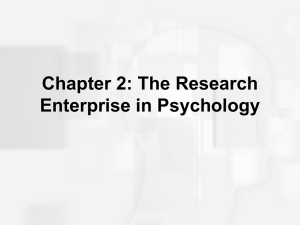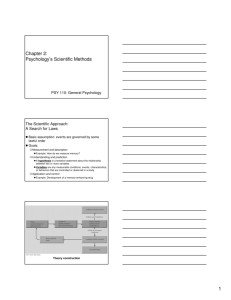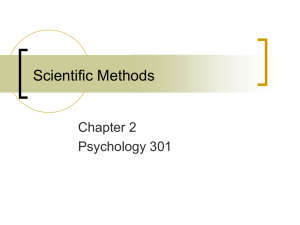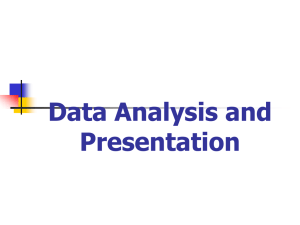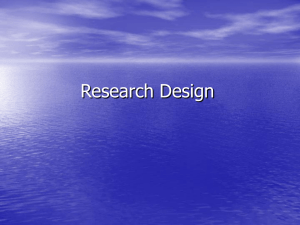Chapter 2 PP - Doral Academy Preparatory
advertisement
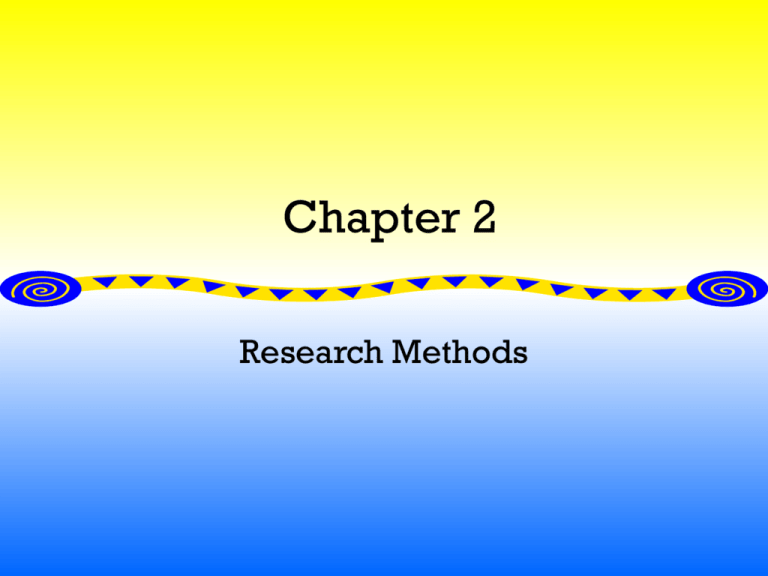
Chapter 2 Research Methods The Scientific Approach: A Search for Laws • Empiricism: testing hypothesis • Basic assumption: events are governed by some lawful order • Goals: – Measurement and description – Understanding and prediction – Application and control • Goal of theory testing in science: refutation not proving – Karl Popper What is Experimental Research? • Explores cause and effect relationships • Has control and experimental groups • Laboratory experiments are good at controlling variables. Implementing school uniforms causes Less violence in school Steps in Designing an Experiment 1. Hypothesis 2. Design Study: Pick Population: Random Selection then Random Assignment. Operationalize the Variables Identify Independent and Dependent Variables. Look for Extraneous Variables Type of Experiment: Blind, Double Blind etc.. 3. Gather Data 4. Analyze Results 5. Publish Experimental Research: Looking for Causes • Experiment = manipulation of one variable under controlled conditions so that resulting changes in another variable can be observed – Detection of cause-and-effect relationships • Independent variable (IV) = variable manipulated • Dependent variable (DV) = variable affected by manipulation – How does X affect Y? – X= Independent Variable, and Y= Dependent Variable Experimental and Control Groups: The Logic of the Scientific Method • Experimental group – subjects who receive some special treatment in regard to the independent variable • Control group – similar subjects who do not receive the special treatment – Logic: • Two groups alike in all respects (random assignment) • Manipulate independent variable for one group only • Resulting differences in the two groups must be due to the independent variable • Extraneous and confounding variables Experimental Designs: Variations • Expose a single group to two different conditions – Reduces extraneous variables • Manipulate more than one independent variable – Allows for study of interactions between variables • Use more than one dependent variable – Obtains a more complete picture of effect of the independent variable Figure 2.7 Manipulation of two independent variables in an experiment Strengths and Weaknesses of Experimental Research • Strengths: – conclusions about cause-and-effect can be drawn – Probabilistic causality • Weaknesses: – artificial nature of experiments – ethical and practical issues Descriptive/Correlational Methods: Looking for Relationships • Methods used when a researcher cannot manipulate the variables under study • Naturalistic observation • Case studies • Surveys – Allow researchers to describe patterns of behavior and discover links or associations between variables but cannot imply causation Figure 2.9 Sample from a case study – a descriptive research method Statistics and Research: Drawing Conclusions • Statistics – using mathematics to organize, summarize, and interpret numerical data • Descriptive statistics: organizing and summarizing data • Inferential statistics: interpreting data and drawing conclusions – use of probability Descriptive Statistics: Measures of Central Tendency • Measures of central tendency = typical or average score in a distribution • Mean: arithmetic average of scores • Median: score falling in the exact center • Mode: most frequently occurring score – Which most accurately depicts the typical? Descriptive Statistics: Variability • Variability = how much scores vary from each other and from the mean – Standard deviation = numerical depiction of variability • High variability in data set = high standard deviation • Low variability in data set = low standard deviation Descriptive Statistics: Correlation • When two variables are related to each other, they are correlated • Correlation = numerical index of degree of relationship – Correlation expressed as a number between 0 and 1 – Can be positive or negative – Numbers closer to 1 (+ or -) indicate stronger relationship Figure 2.13 Positive and negative correlation XX 2.14 Correlation: Prediction, Not Causation • Higher correlation coefficients = increased ability to predict one variable based on the other Example: SAT/ACT scores moderately correlated with first year college GPA • 2 variables may be highly correlated, but not causally related – Foot size and vocabulary positively correlated – Do larger feet cause larger vocabularies? – The third variable problem Inferential Statistics: Interpreting Data and Drawing Conclusions • Hypothesis testing: do observed findings support the hypotheses? – Are findings real or due to chance? • Statistical significance = when the probability that the observed findings are due to chance is very low – Very low = less than 5 chances in 100/ .05 level – Other factors might account for the result Evaluating Research: Methodological Pitfalls • Sampling bias • Placebo effects – is not always uniform – cost factors and perceived pain • Distortions in self-report data: – Social desirability bias – Response set • Experimenter bias – the double-blind solution – Research protocol of clinical trial for drugs – FDA in U.S. Ethics in Psychological Research: Do the Ends Justify the Means? • Question of deception • The question of animal research – Controversy among psychologists and the public • Ethical standards for research: the American Psychological Association – Ensures both human and animal subjects are treated with dignity
